Brook, Kent (†Canterbury) c.1250
Passion Cycle (chancel)
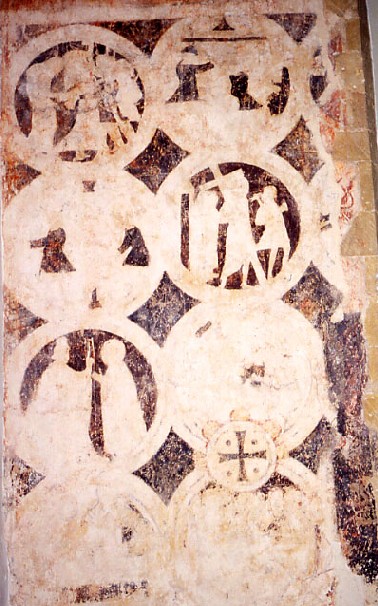
The main photograph at the left below shows most of the individual scenes in this Passion Cycle. They are on the north (left) side of the east wall of the chancel, but the story actually begins low down on the same wall to the south (right) of the east window, where it continues and completes a series illustrating the life and earthly ministry of Christ. The Brook Infancy Cycle, which includes some very rare scenes indeed, is newly on the site, and and the equally rare Miracle scenes – the Raising of Lazarus & Raising of Jairus’s daughter have here for some time.
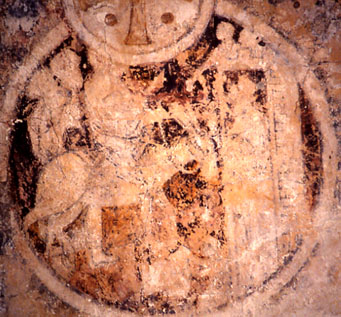
But here the first extant Passion scene, the Entry into Jerusalem, is shown at the right. Christ, astride a long-eared donkey, approaches the gate of Jerusalem, from the top of which several figures welcome him. Two other figures follow (left of picture), and another faint one crouches near the donkey’s forelegs, spreading a garment (the odd-looking detail overlapping this roundel or medallion at the top is part of a later consecration cross superimposed on it). The next roundel, to the right of this one, has the Agony in the Garden, too badly damaged and faded to show here.
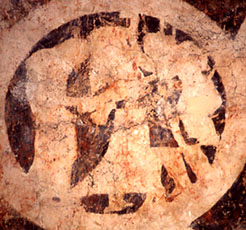
The story then moves to the north of the window, where it unfolds with the Betrayal/Arrest in Gethsemane at the top left in the main photograph above left and shown enlarged at the left here. Christ and Judas embrace in the centre, Christ at the left in a dark robe hard to separate from the darker background, Judas in lighter garments. Across them slant the arm and sword of Peter, cutting off the ear of Malchus, who is the figure in the short dark robe standing on the right with at least one other servant/soldier of the High Priest.
The next roundels, all very indistinct, (main picture) continue the narrative through various scenes of mockery and torture and culminate in the Flagellation. This is the scene at the left of the second row of roundels, and it too is damaged and unclear. Enough can be seen though to identify the pillar of the Flagellation in the centre and the energetic attitudes of those whipping Christ on either side.
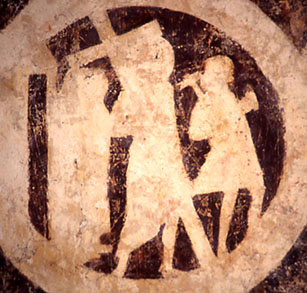
The next scene (second row, right), the Road to Calvary, is shown enlarged at the right. The starkly silhouetted figures, Christ in the centre, a man with a hammer leading him at the right, and (probably) two women followers at the left, show well despite the loss of detail. Missing scenes to the right – at least one, possibly two – have gone with the later enlargement of the east window, and these must have included the Crucifixion.
The next scene (third tier, left) was tentatively identified by Tristram¹ as Joseph of Arimathea asking Pilate for permission to take down Christ’s body, as in Matthew 27: 57-58.
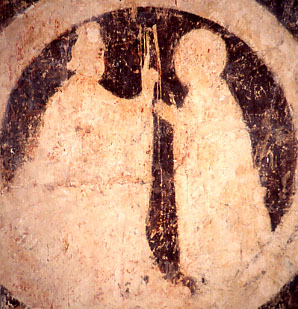
Joseph (below left), with a halo, is at the right, hands together in an attitude of supplication. Pilate, seated at the left, holds up his finger in a gesture of command. The next scene to the right of this (third tier, right) is likely to be the Deposition, as Tristram, who could see the details a little more clearly, thought. The edge of another destroyed subject shows to the immediate right of this one.
Two more scenes form the fourth tier in the main picture above. Faint and faded as both are they are nevertheless identifiable as the Entombment and the Three Maries at the Sepulchre, but even at close quarters no detail is visible.
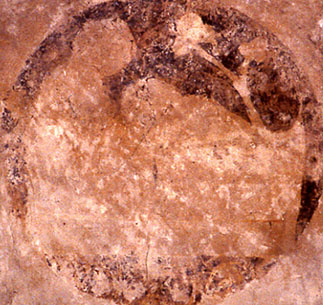
There are more roundels on the north wall of the chancel (i.e. around the right angle to the left of those already shown), but all are faded to the point of near invisibility. It seems to me likely though that at least some of them deal with the post-Resurrection appearances of Christ, and that one of them, that shown at the left, is the Appearance to Mary Magdalene, in which a tree usually features. I think Mary is the figure at the right bowed in homage, with Christ, the more upright haloed figure at the left, responding to her. The two might be standing in front of the tomb.
The Passion Cycle is only part of the very remarkable painted scheme at Brook, which tells the entire story of the lives of Christ and the Virgin Mary. There are other paintings here too, some of them in the nave, and, in the tower chamber, a very faint 12th century painting of Christ Blessing which I was unable to see.² EW Tristram, who first saw Brook in 1908, has written extensively about its entire painted scheme. He also noted links to Canterbury Cathedral, and resemblances to scenes in the Bible of Robert de Bello, Abbot of St Augustine’s, Canterbury from 1224-53.²
Screen-scale can be misleading – all the roundels are more than 2 feet or 60cm in diameter and the others from this fascinating series will be here at future updates.
¹ Tristram II, 275-281, 510-515, Pls.123-132
² But there is a photograph in Tristram 1 (Supplementary Plate 9b)
³ BM MSt Burney, 3, f. 5v (reproduction in Tristram II, Pl.129)